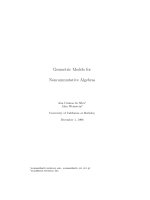- Trang chủ >>
- Khoa Học Tự Nhiên >>
- Vật lý
garcia-bellido j. cosmology for string theorists, a crash course
Bạn đang xem bản rút gọn của tài liệu. Xem và tải ngay bản đầy đủ của tài liệu tại đây (959.88 KB, 93 trang )
ARNOWITT-DESER-MISNER FORMALISM
In the Arnowitt–Deser–Misner formalism the four dimensional metric
g
µν
is parametrized by the three-metric h
ij
and the lapse and shift func-
tions N and N
i
, which describe the evolution of time-like hypersurfaces,
g
00
= −N
2
+ h
ij
N
i
N
j
, g
0i
= g
i0
= N
i
, g
ij
= h
ij
. (1)
The action for the inflaton scalar field with potential V (φ) in the ADM
formalism has the form
S =
d
4
x
√
−g
1
2κ
2
R −
1
2
(∂φ)
2
− V (φ)
=
d
4
xN
√
h
1
2κ
2
(3)
R + K
ij
K
ij
−K
2
+
1
2
(Π
φ
)
2
−φ
|i
φ
|i
−V (φ)
,
(2)
where κ
2
= 8π G = 8π/M
2
P
is the gravitational coupling defining the
Planck mass and Π
φ
is the scalar-field’s conjugate momentum
Π
φ
=
1
N
(
˙
φ − N
i
φ
|i
) . (3)
Vertical bars denote three-space-covariant derivatives with connections
derived from h
ij
;
(3)
R is the three-space curvature associated with the
metric h
ij
, and K
ij
is the extrinsic curvature three-tensor
K
ij
=
1
2N
(N
i|j
+ N
j|i
−
˙
h
ij
), (4)
where a dot denotes differentiation with respect to the time coordinate.
The traceless part of a tensor is denoted by an overbar. In particular,
¯
K
ij
= K
ij
−
1
3
Kh
ij
, K = K
i
i
=
1
N
N
i|i
− ∂
t
ln
√
h
. (5)
The trace K is a generalization of the Hubble parameter, as will be shown
below. Variation of the action with respect to N and N
i
yields the energy
and momentum constraint equations respectively
−
(3)
R +
¯
K
ij
¯
K
ij
−
2
3
K
2
+ 2κ
2
ρ = 0 ,
¯
K
j
i|j
−
2
3
K
|i
+ κ
2
Π
φ
φ
|i
= 0 .
(6)
Variation with respect to h
ij
gives the dynamical gravitational field
equations, which can be separated into the trace and traceless parts
˙
K − N
i
K
|i
= − N
|i
|i
+ N
1
4
(3)
R +
3
4
¯
K
ij
¯
K
ij
+
1
2
K
2
+
κ
2
2
T
, (7)
˙
¯
K
i
j
− N
k
¯
K
i
j|k
+ N
i
|k
¯
K
k
j
− N
k
|j
¯
K
i
k
= −N
|i
|j
+
1
3
N
|k
|k
δ
i
j
+ N
(3)
¯
R
i
j
+ K
¯
K
i
j
− κ
2
¯
T
i
j
.
(8)
Variation with respect to φ gives the scalar-field’s equation of motion
1
N
(
˙
Π
φ
− N
i
Π
φ
|i
) − KΠ
φ
−
1
N
N
|i
φ
|i
− φ
|i
|i
+
∂V
∂φ
= 0 . (9)
The energy density on a constant-time hypersurface is
ρ =
1
2
(Π
φ
)
2
+ φ
|i
φ
|i
+ V (φ), (10)
and the stress three-tensor
T
ij
= φ
|i
φ
|j
+ h
ij
1
2
(Π
φ
)
2
− φ
|k
φ
|k
− V (φ)
. (11)
It is extremely difficult to solve these highly nonlinear coupled equa-
tions in a cosmological scenario without making some approximations.
The usual approach is to assume homogeneity of the fields to give a
background solution and then linearize the equations to study deviations
from spatial uniformity. The smallness of cosmic microwave background
anisotropies gives some justification for this perturbative approach at
least in our local part of the Universe. However, there is no reason to
believe it will be valid on much larger scales. In fact, the stochastic ap-
proach to inflation suggests that the Universe is extremely inhomogeneous
on very large scales. Fortunately, in this framework one can coarse-grain
over a horizon distance and separate the short- from the long-distance
behavior of the fields, where the former communicates with the latter
through stochastic forces. The equations for the long-wavelength back-
ground fields are obtained by neglecting large-scale gradients, leading to
a self-consistent set of equations, as we will discuss in the next section.
SPATIAL GRADIENT EXPANSION
It is reasonable to expand in spatial gradients whenever the forces aris-
ing from time variations of the fields are much larger than forces from
spatial gradients. In linear perturbation theory one solves the perturba-
tion equations for evolution outside of the horizon: a typical time scale
is the Hubble time H
−1
, which is assumed to exceed the gradient scale
a/k, where k is the comoving wave number of the perturbation. Since
we are interested in structures on scales larger than the horizon, it is
reasonable to expand in k/(aH). In particular, for inflation this is an
appropriate parameter of expansion since spatial gradients become ex-
ponentially negligible after a few e-folds of expansion beyond horizon
crossing, k = aH.
It is therefore useful to split the field φ into coarse-grained long-
wavelength background fields φ(t, x
j
) and residual short-wavelength fluc-
tuating fields δφ(t, x
j
). There is a preferred timelike hypersurface within
the stochastic inflation approach in which the splitting can be made con-
sistently, but the definition of the background field will depend on the
choice of hypersurface, i.e. the smoothing is not gauge invariant. For
stochastic inflation the natural smoothing scale is the comoving Hubble
length (aH)
−1
and the natural hypersurfaces are those on which aH is
constant. In that case a fundamental difference between between φ and
δφ is that the short-wavelength components are essentially uncorrelated
at different times, while long-wavelength components are deterministi-
cally correlated through the equations of motion.
In order to solve the equations for the background fields, we will have
to make suitable approximations. The idea is to expand in the spatial
gradients of φ and to treat the terms that depend on the fluctuating fields
as stochastic forces describing the connection between short- and long-
wavelength components. In this Section we will neglect the stochastic
forces due to quantum fluctuations of the scalar fields and will derive the
approximate equation of motion for the background fields. We retain only
those terms that are at most first order in spatial gradients, neglecting
such terms as φ
|i
|i
, φ
|i
φ
|i
,
(3)
R,
(3)
R
j
i
, and
¯
T
j
i
.
We will also choose the simplifying gauge N
i
= 0 [Note that for the
evolution during inflation this is a consequence of the rapid expansion,
more than a gauge choice]. The evolution equation (8) for the traceless
part of the extrinsic curvature is then
˙
¯
K
i
j
= NK
¯
K
i
j
. Using NK =
−∂
t
ln
√
h from (5), we find the solution
¯
K
i
j
∝ h
−1/2
, where h is the
determinant of h
ij
. During inflation h
−1/2
≡ a
−3
, with a the overall
expansion factor, therefore
¯
K
i
j
decays extremely rapidly and can be set
to zero in the approximate equations. The most general form of the
three-metric with vanishing
¯
K
i
j
is
h
ij
= a
2
(t, x
k
) γ
ij
(x
k
), a(t, x
k
) ≡ exp[α(t, x
k
)], (12)
where the time-dependent conformal factor is interpreted as a space-
dependent expansion factor. The time-independent three-metric γ
ij
, of
unit determinant, describes the three-geometry of the conformally trans-
formed space. Since a(t, x
k
) is interpreted as a scale factor, we can sub-
stitute the trace K of the extrinsic curvature for the Hubble parameter
H(t, x
i
) ≡
1
N(t, x
i
)
˙α(t, x
i
) = −
1
3
K(t, x
i
). (13)
The energy and momentum constraint equations (6) can now be writ-
ten as
H
2
=
κ
2
3
1
2
(Π
φ
)
2
+ V (φ)
, (14)
H
|i
= −
κ
2
2
Π
φ
φ
|i
, (15)
together with the evolution equation (7)
−
1
N
˙
H =
3
2
H
2
+
κ
2
6
T =
κ
2
2
(Π
φ
)
2
, (16)
where T = 3
1
2
(Π
φ
)
2
− V (φ)
.
In general, H is a function of the scalar field and time, H(t, x
i
) ≡
H(φ(t, x
i
), t). From the momentum constraint (15) we find that the
scalar-field’s momentum must obey
Π
φ
= −
2
κ
2
∂H
∂φ
t
. (17)
Comparing Eq. (16) with the time derivative of H(φ, t),
1
N
∂H
∂t
x
= Π
φ
∂H
∂φ
t
+
1
N
∂H
∂t
φ
= −
κ
2
2
(Π
φ
)
2
+
1
N
∂H
∂t
φ
,
(18)
we find
∂H
∂t
φ
= 0.
In fact, we should not be surprised since this is actually a consequence
of the general covariance of the theory.
On the other hand, the scalar field’s equation (9) can be written to
first order in spatial gradients as
1
N
˙
Π
φ
+ 3HΠ
φ
+
∂V
∂φ
= 0 . (19)
We can also show that the conjugate momentum Π
φ
does not depend
explicitly on time, its only dependence comes through φ. For this, differ-
entiate Eq. (14) w.r.t. φ to obtain
Π
φ
∂Π
φ
∂φ
t
+ 3H Π
φ
+
∂V
∂φ
= 0
and compare with (19), where
1
N
˙
Π
φ
= Π
φ
∂Π
φ
∂φ
t
+
∂Π
φ
∂t
φ
, (20)
which implies
∂Π
φ
∂t
φ
= 0.
HAMILTON-JACOBI FORMALISM
We can now summarise what we have learned. The evolution of a
general foliation of space-time in the presence of a scalar field fluid can
be described solely in terms of the rate of expansion, which is a function
of the scalar field only, H ≡ H(φ(t, x
i
)), satisfying the Hamiltonian
constraint equation:
3H
2
(φ) =
2
κ
2
∂H
∂φ
2
+ κ
2
V (φ) , (21)
together with the momentum constraint and the evolution of the scale
factor,
1
N
˙
φ = −
κ
2
2
∂H
∂φ
= Π
φ
(22)
1
N
˙α = H(φ) , (23)
as well as the dynamical gravitational and scalar field evolution equations
1
N
˙
H = −
2
κ
2
∂H
∂φ
2
= −
κ
2
2
(Π
φ
)
2
, (24)
1
N
˙
Π
φ
= −3H Π
φ
− V
(φ) . (25)
Therefore, H(φ) is all you need to specify (to second order in field
gradients) the evolution of the scale factor and the scalar field during
inflation.
These equations are still too complicated to solve for arbitrary po-
tentials V (φ). In the next section we will find solutions to them in the
slow-roll approximation.
SLOW-ROLL APPROXIMATION AND ATTRACTOR
Given the complete set of constraints and evolution equations (21) -
(25), we can construct the following parameters,
≡ −
˙
H
H
2
=
2
κ
2
H
(φ)
H(φ)
2
= −
∂ ln H
∂ ln a
, (26)
δ ≡ −
¨
φ
H
˙
φ
=
2
κ
2
H
(φ)
H(φ)
= −
∂ ln H
∂ ln a
, (27)
in terms of which we can define the number of e-folds N
e
as
N
e
≡ ln
a
end
a(t)
=
t
end
t
Hdt = −
κ
2
2
φ
end
φ
H(φ)dφ
H
(φ)
. (28)
In order for inflation to be predictive, you need to ensure that inflation
is independent of initial conditions. That is, one should ensure that there
is an attractor solution to the dynamics, such that differences between
solutions corresponding to different initial conditions rapidly vanish.
Let H
0
(φ) be an exact, particular, solution of the constraint equation
(21), either inflationary or not. Add to it a homogeneous linear pertur-
bation δH(φ), and substitute into (21). The linear perturbation equation
reads H
0
(φ) δH
(φ) = (3κ
2
/2) H
0
δH, whose general solution is
δH(φ) = δH(φ
i
) exp
3κ
2
2
φ
φ
i
H
0
(φ)dφ
H
0
(φ)
= δH(φ
i
) exp(−3∆N) ,
(29)
where ∆N = N
i
− N > 0, and we have used (28) with the particular
solution H
0
(φ). This means that very quickly any deviation from the
attractor dies away. This ensures that we can effectively reduce our two-
dimensional space (φ, Π
φ
) to just a single trajectory in phase space.
As a consequence, regardless of the initial condition, the attractor
behaviour implies that late-time solutions are the same up to a constant
time shift, which cannot be measured.
AN EXAMPLE: POWER-LAW INFLATION
An exponential potential is a particular case where the attractor can
be found explicitly and one can study the approach to it, for an arbitrary
initial condition.
Consider the inflationary potential
V (φ) = V
0
e
−βκφ
, (30)
with β 1 for inflation to proceed. A particular solution to the Hamil-
tonian constraint equation (21) is
H
att
(φ) = H
0
e
−
1
2
βκφ
, (31)
H
2
0
=
κ
2
3
V
0
1 −
β
2
6
−1
. (32)
This model corresponds to an inflationary universe with a scale factor
that grows like
a(t) ∼ t
p
, p =
2
β
2
1 . (33)
The slow-roll parameters are both constant,
=
2
κ
2
H
(φ)
H(φ)
2
=
β
2
2
=
1
p
1 , (34)
δ =
2
κ
2
H
(φ)
H(φ)
=
β
2
2
=
1
p
1 . (35)
All trajectories tend to the attractor (31), while we can also write down
the solution corresponding to the slow-roll approximation, = δ = 0,
H
2
SR
(φ) =
κ
2
3
V
0
e
−βκφ
, (36)
which differs from the actual attractor by a tiny constant factor, 3p/(3p−
1) 1, responsible for a constant time-shift which cannot be measured.
HOMOGENEOUS SCALAR FIELD DYNAMICS
Singlet minimally coupled scalar field φ, with effective potential V (φ)
S
inf
=
d
4
x
√
−g L
inf
, L
inf
= −
1
2
g
µν
∂
µ
φ∂
ν
φ − V (φ) . (1)
Its evolution equation in a Friedmann-Robertson-Walker metric:
¨
φ −
1
a
2
∇
2
φ + 3H
˙
φ + V
(φ) = 0 , (2)
together with the Einstein equations,
H
2
=
κ
2
3
1
2
˙
φ
2
+
1
2a
2
(∇φ)
2
+ V (φ)
, (3)
˙
H = −
κ
2
2
˙
φ
2
, (4)
where κ
2
≡ 8πG. The inflation dynamics described as a perfect fluid
with a time-dependent pressure and energy density given by
ρ =
1
2
˙
φ
2
+
1
2a
2
(∇φ)
2
+ V (φ) , (5)
p =
1
2
˙
φ
2
−
1
6a
2
(∇φ)
2
− V (φ) . (6)
The field evolution equation (2) implies the energy conservation equation,
˙ρ + 3H(ρ + p) = 0 . (7)
If the potential energy density of the scalar field dominates the kinetic
and gradient energy, V (φ)
˙
φ
2
,
1
a
2
(∇φ)
2
, then
p −ρ ⇒ ρ const. ⇒ H(φ) const. , (8)
which leads to the solution
a(t) ∼ exp(Ht) ⇒
¨a
a
> 0 accelerated expansion . (9)
Definition: number of e-folds,
N ≡ ln(a/a
i
) ⇒ a(N) = a
i
exp(N)
THE SLOW-ROLL APPROXIMATION
During inflation, the scalar field evolves very slowly down its effective
potential. We can then define the slow-roll parameters,
≡ −
˙
H
H
2
=
κ
2
2
˙
φ
2
H
2
1 , (10)
δ ≡ −
¨
φ
H
˙
φ
1 . (11)
The condition which characterizes inflation is
< 1 ⇐⇒
¨a
a
> 0 , (12)
i.e. horizon distance d
H
∼ H
−1
grows more slowly than scale factor a.
The number of e-folds during inflation:
N = ln
a
end
a
i
=
t
e
t
i
Hdt =
φ
e
φ
i
κdφ
2(φ)
. (13)
The evolution equations (2) and (3) become
H
2
1 −
3
H
2
=
κ
2
3
V (φ) , (14)
3H
˙
φ
1 −
δ
3
3H
˙
φ = −V
(φ) . (15)
Phase space reduction for single-field inflation, H(φ,
˙
φ) → H(φ) .
=
1
2κ
2
V
(φ)
V (φ)
2
1 ,
η =
1
κ
2
V
(φ)
V (φ)
1 ,
N = κ
2
φ
e
φ
i
V (φ) dφ
V
(φ)
.
GAUGE INVARIANT LINEAR PERTURBATION THEORY
The unperturbed (background) FRW metric can be described by a
scale factor a(t) and a homogeneous scalar field φ(t),
ds
2
= a
2
(η)[−dη
2
+ γ
ij
dx
i
dx
j
] , (16)
φ = φ(η) , (17)
where η is the conformal time η =
dt
a(t)
and the background equations of motion can be written as
H
2
=
κ
2
3
1
2
φ
2
+ a
2
V (φ)
, (18)
H
− H
2
=
κ
2
2
φ
2
, (19)
φ
+ 2Hφ
+ a
2
V
(φ) = 0 , (20)
where H = aH and φ
= a
˙
φ.
During inflation, the quantum fluctuations of the scalar field will in-
duce metric perturbations which will backreact on the scalar field.
The most general line element, in linear perturbation theory, with
both scalar and tensor metric perturbations [inflation cannot generate,
to linear order, a vector perturbation], is given by
ds
2
= a
2
(η)
−(1 + 2A)dη
2
+ 2B
|i
dx
i
dη
+ {(1 + 2R)γ
ij
+ 2E
|ij
+ 2h
ij
}dx
i
dx
j
, (21)
φ = φ(η) + δφ(η, x
i
) . (22)
The indices {i, j} label the three-dimensional spatial coordinates with
metric γ
ij
, and the |i denotes covariant derivative with respect to that
metric. The gauge-invariant tensor perturbation h
ij
corresponds to a
transverse traceless gravitational wave, ∇
i
h
ij
= h
i
i
= 0.
GAUGE INVARIANT GRAVITATIONAL POTENTIALS
The four scalar metric perturbations (A, B, R, E) and the field per-
turbation δφ are all gauge dependent functions of (η, x
i
). The tensor
perturbation h
ij
is gauge independent.
Under a general coordinate (gauge) transformation
˜η = η + ξ
0
(η, x
i
) , (23)
˜x
i
= x
i
+ γ
ij
ξ
|j
(η, x
i
) , (24)
with arbitrary functions (ξ
0
, ξ), the scalar and tensor perturbations trans-
form, to linear order, as
˜
A = A −ξ
0
− Hξ
0
,
˜
B = B + ξ
0
− ξ
, (25)
˜
R = R − Hξ
0
,
˜
E = E −ξ , (26)
˜
h
ij
= h
ij
, (27)
(where primes denote derivatives with respect to conformal time).
Possible to construct two gauge-invariant gravitational potentials,
Φ = A + (B −E
)
+ H(B − E
) , (28)
Ψ = R+ H(B −E
) , (29)
which are related through the perturbed Einstein equations,
Φ = −Ψ , (30)
k
2
a
2
Ψ = 4π G δρ , (Poisson) (31)
where δρ is the gauge-invariant density perturbation corresponding to
the scalar field.
Consider the action (1) with line element
ds
2
= a(η)
2
−(1 + 2Φ)dη
2
+ (1 − 2Φ)dx
2
in the Longitudinal gauge, where Φ is the gauge-invariant gravitational
potential (28). Then the gauge-invariant equations for the perturbations
on comoving hypersurfaces (constant energy density hypersurfaces) are
Φ
+ 3HΦ
+ (H
+ H
2
)Φ =
κ
2
2
[φ
δφ
− a
2
V
(φ)δφ] , (32)
−∇
2
Φ + 3HΦ
+ (H
+ H
2
)Φ = −
κ
2
2
[φ
δφ
+ a
2
V
(φ)δφ] , (33)
Φ
+ HΦ =
κ
2
2
φ
δφ , (34)
δφ
+ 2Hδφ
− ∇
2
δφ = 4φ
Φ
− 2a
2
V
(φ)Φ − a
2
V
(φ)δφ .
This system of equations seem too difficult to solve at first sight.
However, there is a gauge invariant combination of Mukhanov variables
u ≡ aδφ + zΦ ,
z ≡ a
φ
H
.
for which the above equations simplify enormously,
u
− ∇
2
u −
z
z
u = 0 ,
∇
2
Φ =
κ
2
2
H
a
2
(zu
− z
u) ,
a
2
Φ
H
=
κ
2
2
zu .
From these, we can find a solution u(z), which can be integrated to give
Φ(z), and together allow us to obtain δφ(z).
QUANTUM FIELD THEORY IN CURVED SPACE-TIME
We should consider the perturbations Φ and δφ as quantum field fluc-
tuations. Note that the perturbed action for the scalar mode u can be
written as
δS =
1
2
d
3
x dη
(u
)
2
− (∇u)
2
+
z
z
u
2
. (35)
Quantize the field u in the curved background: write the operator
ˆu(η, x) =
d
3
k
(2π)
3/2
u
k
(η) ˆa
k
e
i k·x
+ u
∗
k
(η) ˆa
†
k
e
−i k·x
, (36)
with
[ˆa
k
, ˆa
†
k
] = δ
3
(k − k
) , ˆa
k
|0 = 0 . (37)
Each mode u
k
(η) decouples in linear perturbation theory,
u
k
+
k
2
−
z
z
u
k
= 0
This is a Schr¨odinger-like equation with potential U(η) = z
/z.
We will use the slow-roll parameters (10),
= 1 −
H
H
2
=
κ
2
2
z
2
a
2
const. 1 , (38)
δ = 1 −
φ
Hφ
= 1 + −
z
Hz
const. 1 . (39)
In terms of these parameters, the conformal time and the effective po-
tential for the u
k
mode can be written as
η =
−1
H
1
1 −
, (40)
z
z
=
1
η
2
ν
2
−
1
4
, where ν =
1 + − δ
1 −
+
1
2
. (41)
EXACT SOLUTIONS
In the slow-roll approximation, the effective potential is z
/z 2H
2
.
The exact solutions are (Hankel: H
(1)
3/2
(x) = −e
ix
2/πx(1 + i/x)),
u
k
(η) =
√
π
2
e
i(ν+
1
2
)
π
2
(−η)
1/2
H
(1)
ν
(−kη) , (42)
De Sitter Event horizon H
−1
sets the physical scale,
u
k
=
1
√
2k
e
−ikη
k aH , (Minkowsky vacuum)
u
k
= C
1
z k aH . (superhorizon modes)
In the superhorizon limit kη → 0, the solution becomes
|u
k
|
1
√
2k
k
aH
1
2
−ν
, for , δ 1 . (43)
Φ
k
= C
1
(k)
1 −
H
a
2
a
2
dη
+ C
2
(k)
H
a
2
, (44)
δφ
k
=
C
1
(k)
a
2
a
2
dη −
C
2
(k)
a
2
. (45)
where C
1
(k) ⇒ growing solution, C
2
(k) ⇒ decaying solution.
For adiabatic perturbations, we can find a gauge invariant quantity
that is also constant for superhorizon modes,
ζ ≡ Φ +
1
H
(Φ
+ HΦ) =
u
z
R
c
, for k aH
R
c
= gauge-invariant curvature perturbation on comoving hypersurfaces.
Can evaluate Φ
k
when perturbation reenters the horizon during radi-
ation/matter eras in terms of the curvature perturbation R
k
when it left
the Hubble scale during inflation,
Φ
k
=
1 −
H
a
2
a
2
dη
R
k
=
3 + 3ω
5 + 3ω
R
k
=
2
3
R
k
radiation era ,
3
5
R
k
matter era .
GRAVITATIONAL WAVE PERTURBATIONS
The action for the tensor perturbation h
ij
as quantum field
δS =
1
2
d
3
x dη
a
2
2κ
2
(h
ij
)
2
− (∇h
ij
)
2
, (46)
ˆ
h
ij
(η, x) =
d
3
k
(2π)
3/2
λ=1,2
h
k
(η) e
ij
(k, λ) ˆa
k,λ
e
i k·x
+ h.c.
, (47)
where e
ij
(k, λ) are the two symmetric e
ij
= e
ji
, transverse k
i
e
ij
= 0, and
traceless e
ii
= 0 polarization tensors, e
ij
(−k, λ) = e
∗
ij
(k, λ), satisfying
λ
e
∗
ij
(k, λ)e
ij
(k, λ) = 4. Redefine the gauge invariant tensor mode,
v
k
(η) =
a
√
2κ
h
k
(η) , (48)
satisfying decoupled evolution equations, in linear perturbation theory,
v
k
+
k
2
−
a
a
v
k
= 0 . (49)
For constant slow-roll parameters, the potential becomes
a
a
= 2H
2
1 −
2
=
1
η
2
µ
2
−
1
4
, µ =
1
1 −
+
1
2
.
We can solve equation (49) exactly in terms of the Hankel function (42)
with ν → µ. In the two asymptotic regimes,
v
k
=
1
√
2k
e
−ikη
k aH , (Minkowsky vacuum)
v
k
= C a k aH . (superhorizon modes)
In the superhorizon limit kη → 0, the solution becomes
|v
k
| =
1
√
2k
k
aH
1
2
−µ
. (50)
Since h
k
is constant on superhorizon scales, we can evaluate the tensor
metric perturbation when it reentered during the radiation/matter eras
directly in terms of its value during inflation.
POWER SPECTRA OF SCALAR AND TENSOR METRIC
PERTURBATIONS
Let us consider first the scalar (density) metric perturbations R
k
,
which enter the horizon at a = k/H. Its two-point correlation func-
tion is given by
0|R
∗
k
R
k
|0 =
|u
k
|
2
z
2
δ
3
(k − k
) ≡
P
R
(k)
4πk
3
(2π)
3
δ
3
(k − k
) , (51)
P
R
(k) =
k
3
2π
2
|u
k
|
2
z
2
=
κ
2
2
H
2π
2
k
aH
3−2ν
≡ A
2
S
k
aH
n−1
(52)
This equation determines the power spectrum in terms of its amplitude
at horizon-crossing, A
S
, and a tilt,
n − 1 ≡
d ln P
R
(k)
d ln k
= 3 − 2ν = 2
δ −2
1 −
2η −6 , (53)
It is possible, in principle, to obtain from inflation a scalar tilt which is
either positive (n > 1) or negative (n < 1). Furthermore, depending
on the particular inflationary model, we can have significant departures
from scale invariance.
Let us consider now the tensor (gravitational wave) metric perturba-
tion, which enter the horizon at a = k/H,
λ
0|h
∗
k,λ
h
k
,λ
|0 =
8κ
2
a
2
|v
k
|
2
δ
3
(k − k
) ≡
P
g
(k)
4πk
3
(2π)
3
δ
3
(k − k
)(54)
P
g
(k) = 8κ
2
H
2π
2
k
aH
3−2µ
≡ A
2
T
k
aH
n
T
. (55)
Therefore, the power spectrum can be approximated by a power-law
expression, with amplitude A
T
and tilt
n
T
≡
d ln P
g
(k)
d ln k
= 3 − 2µ = −
2
1 −
−2 < 0 , (56)
which is always negative. In the slow-roll approximation, 1, the
tensor power spectrum is approximately scale invariant.









